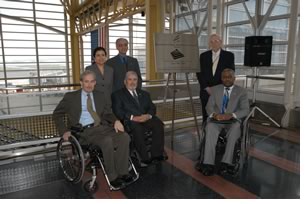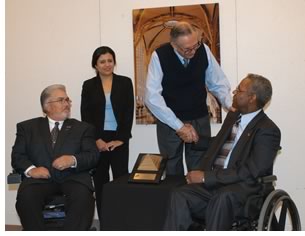

Paralyzed Veterans Honor Pelli for Accessible Design
 This
spring, the Paralyzed Veterans of America (PVA) presented Cesar Pelli,
FAIA, with its 2003 Barrier-Free America Award for the architect’s
design of Ronald Reagan Washington National Airport, through which more
than 130 million travelers pass every year. Pelli, the 1995 recipient
of the AIA Gold Medal, said “I am delighted to share with an organization
as esteemed as the PVA our vision of a more humane and barrier-free architecture.
It reinforces the premise that good design can also mean accessible design.”
This
spring, the Paralyzed Veterans of America (PVA) presented Cesar Pelli,
FAIA, with its 2003 Barrier-Free America Award for the architect’s
design of Ronald Reagan Washington National Airport, through which more
than 130 million travelers pass every year. Pelli, the 1995 recipient
of the AIA Gold Medal, said “I am delighted to share with an organization
as esteemed as the PVA our vision of a more humane and barrier-free architecture.
It reinforces the premise that good design can also mean accessible design.”
The PVA applauded Pelli’s vision, which eases airport use for people with disabilities. “His design of National Airport makes a real difference every day in the lives of thousands of disabled travelers who come to Washington knowing the airport is accommodating and obstacle-free,” stated their release.
PVA National Architecture Director Carol Paredo Lopez, AIA, noted that in addition to Pelli, credit for the airport’s commitment to accessibility should also go to the architects at the Metropolitan Washington Airports Authority, including Daniel Feil, FAIA. In an article for Paraplegia News, a PVA publication, Lopez noted that the new terminal design was completed contemporaneously with the passage of the Americans With Disabilities Act (ADA) and the Air Carriers Access Act (ACAA), “at a time when most architects and designers were still learning about accessible design.” Lopez also wrote, in further support of Pelli, that he says his firm has always made accessibility a priority.
 “In
practically every public building they design,” Lopez reported,
“Pelli’s architects meet with disability groups to discuss
accessibility issues.” Pelli told Lopez, “Everyone in our
firm is aware the more we talk with users, the better we understand what
we can do. We design from the beginning with the intention of making it
accessible. It’s not a question of complying with codes.”
“In
practically every public building they design,” Lopez reported,
“Pelli’s architects meet with disability groups to discuss
accessibility issues.” Pelli told Lopez, “Everyone in our
firm is aware the more we talk with users, the better we understand what
we can do. We design from the beginning with the intention of making it
accessible. It’s not a question of complying with codes.”
Pelli’s design considered accessibility in many concrete ways, particularly in the area of wayfinding. For example, Lopez noted, “Directional wayfinding is accomplished through clarity of space and systematic organization of function.” The new terminal has dark floors that contrast with light-colored walls. Different types of visual information are carefully formatted for clarity and function. For example, signage for retail facilities is presented differently from passenger information. In addition, cassette tapes with descriptive information are available for people with visual impairments.
 All new terminal
entrances and drop-off areas are wheelchair accessible, and vertical movement
is eased with a choice of circulation systems. “The levels within
the terminal are carefully organized for efficiency and passenger convenience.
Passengers, for example, can be dropped off at the third level and proceed
directly to the check-in counters. The second level connects to the public
parking, the subway, and the original terminals,” eliminating the
need to cross vehicular traffic, Lopez pointed out.
All new terminal
entrances and drop-off areas are wheelchair accessible, and vertical movement
is eased with a choice of circulation systems. “The levels within
the terminal are carefully organized for efficiency and passenger convenience.
Passengers, for example, can be dropped off at the third level and proceed
directly to the check-in counters. The second level connects to the public
parking, the subway, and the original terminals,” eliminating the
need to cross vehicular traffic, Lopez pointed out.
Specific services and facilities that minimize barriers and improve accessibility
are:
• Accessible ticket-counters
• A telecommunications-device-for-the-deaf (TDD) phone and at least
one wheelchair accessible telephone are located at every public phone
bank
• Dedicated areas for pickup of arriving passengers with disabilities
(with TDD phones)
• A visual paging system and an audible public-address system
• Wheelchair availability
• Elevators with raised Braille buttons and electronic voice
• Parking for individuals with disabilities
• New airport shuttle buses with wheelchair lifts
• A subway with terminal access.
Copyright 2003 The American Institute of Architects.
All rights reserved. Home Page ![]()
![]()
 |
||
| Click here (2.9 Mb PDF) for the full article, “Meeting the Challenge,” by Carol Paredo Lopez, AIA. © 2003 Paralyzed Veterans of America, reprinted by permission of PN/Paraplegic News. Images by Bill Fitz-Patrick © PVA.
|
||